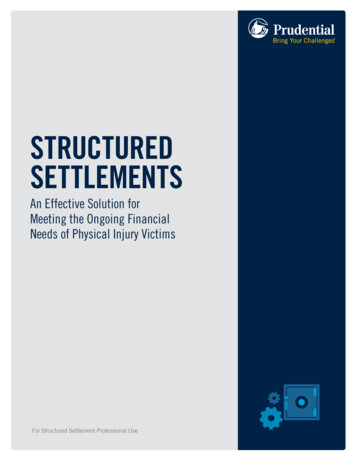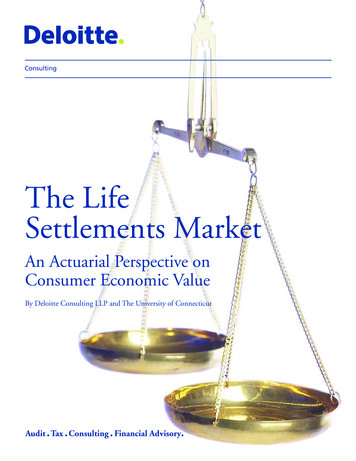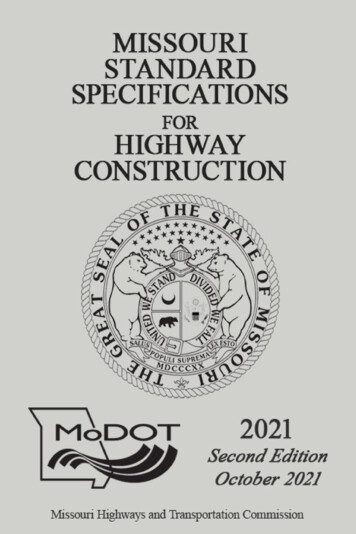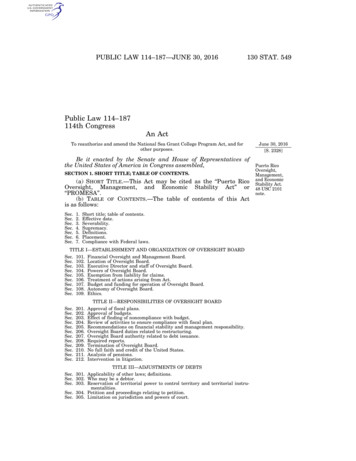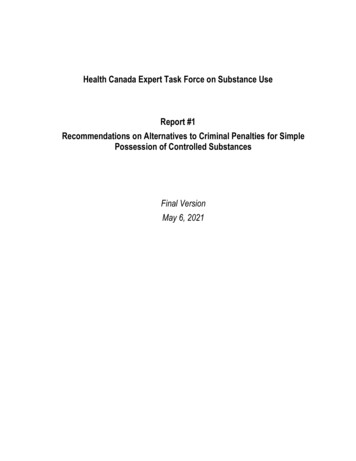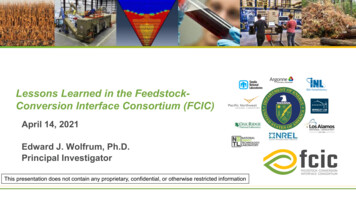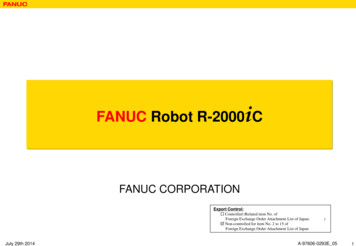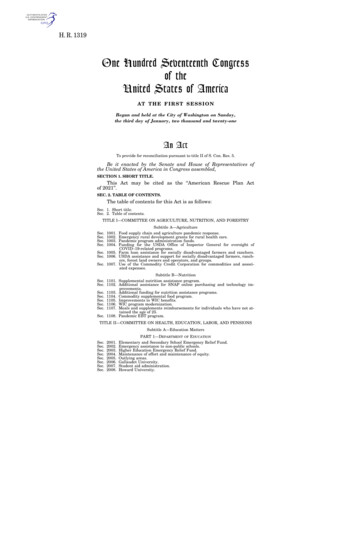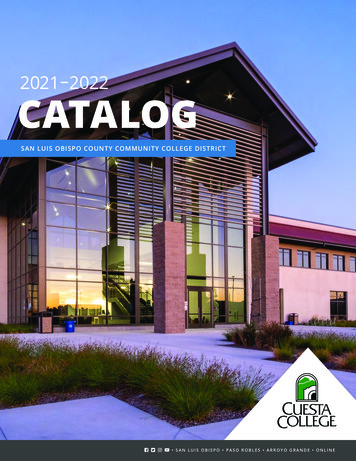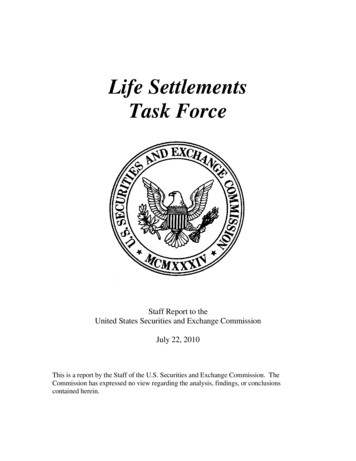
Transcription
Life SettlementsTask ForceStaff Report to theUnited States Securities and Exchange CommissionJuly 22, 2010This is a report by the Staff of the U.S. Securities and Exchange Commission. TheCommission has expressed no view regarding the analysis, findings, or conclusionscontained herein.
Table of ContentsI. Introduction . 1II. Life Settlements . 3A. What is a Life Settlement . 3B. Size of the Life Settlements Market. 4III. Current Practices in the Life Settlements Market . 6A. Market Intermediaries . 71. Brokers and Providers . 72. Life Expectancy Underwriters . 83. Trading Platforms . 104. Secondary Market Companies . 10B. Stranger-Originated Life Insurance (STOLI) . 11C. Securitization of Life Settlements . 14D. Role of Rating Agencies . 17E. Effect of Life Settlements on Life Insurers. 19IV. Regulation of the Life Settlements Market . 21A. Application of the Federal Securities Laws . 211. The Securities Act of 1933 . 212. The Securities Exchange Act of 1934 . 243. Enforcement Actions . 30B. Application of State Insurance and Securities Laws. 331. State Insurance Laws . 332. State Securities Laws . 36V. Recommendations . 39A. The Commission Should Consider Recommending to Congress that It Amend theDefinition of Security under the Federal Securities Laws to Include LifeSettlements . 39B. The Commission Should Instruct the Staff to Continue to Monitor that LegalStandards of Conduct Are Being Met by Brokers and Providers . 42ii
C. The Commission Should Instruct the Staff to Monitor for the Development of aLife Settlement Securitization Market . 42D. The Commission Should Encourage Congress and State Legislators to ConsiderMore Significant and Consistent Regulation of Life Expectancy Underwriters . 43E. The Commission Should Instruct the Staff to Consider Issuing an Investor BulletinRegarding Investments in Life Settlements . 43Appendix A: Task Force Membership . A-1Appendix B: Groups and Individuals Who Met with the Task Force . B-1Appendix C: SEC Enforcement Actions . C-1Appendix D: FINRA Enforcement Actions . D-1Appendix E: Charts Comparing the NAIC and NCOIL Model Acts .E-1iii
Executive SummaryChairman Schapiro established the Life Settlements Task Force in August 2009 toexamine emerging issues in the life settlements market and to advise the Commissionwhether market practices and regulatory oversight could be improved. A life settlementis a transaction in which an insurance policy owner sells a life insurance policy to a thirdparty for an amount that exceeds the policy’s cash surrender value, but is less than theexpected death benefit of the policy. Reports indicate that the life settlements market hadexperienced robust growth up until 2007 when it was estimated that 12 billion in faceamount, or stated benefit amount, of life insurance was sold in life settlementtransactions. More recently, the amount sold has declined. Based on a recent estimate, 7.01 billion of face amount in life insurance was sold in life settlement transactions in2009. 1The Task Force was set up as a cross-Divisional SEC Staff task force to bring amulti-disciplinary approach to the review. The Task Force reviewed articles and otherresources related to life settlements, and met with 23 outside groups knowledgeable aboutthe life settlements market, its regulation, its participants and its impact on policy ownersand investors. In addition to meeting with industry participants, the Task Force also metwith the Financial Industry Regulatory Authority (“FINRA”), the U.K.’s FinancialServices Authority (“FSA”), the U.S. Government Accountability Office (“GAO”), andstate insurance commissioners and securities regulators and their representatives.This Report outlines the Task Force’s findings about the life settlements marketand recommends that the Commission consider certain actions to improve marketpractices and regulatory oversight in the life settlements market. The views expressed inthis Report are those of the Task Force and do not necessarily reflect the views of theCommission or the individual Commissioners.Characteristics of the Life Settlements MarketA life settlement is usually accomplished through the efforts of a number ofmarket intermediaries, each of them dealing with a specific aspect of the settlement of alife insurance policy. Participants in a life settlement transaction generally include aninsured individual or the owner of the policy, a producer who may be a financial advisoror an insurance agent, one or more settlement brokers who may also be insurance agents,one or more life expectancy underwriters, one or more providers who typically representthe party acquiring the policy, and one or more investors.1See U.S. Government Accountability Office, GAO-10-775, Life Insurance Settlements:Regulatory Inconsistencies May Pose a Number of Challenges (2010).iv
Most insured individuals participating in today’s life settlement market are seniorswith a life expectancy of more than two years. 2 Often, insured individuals or policyowners first discuss a life settlement with a producer, who may be the policy owner’sfinancial advisor or the insurance agent who sold the insurance policy to the policyowner. A settlement broker will generally gather the information necessary to sell a lifeinsurance policy to a provider, known as settling the policy, including medicalinformation. Providers will review and bid on settlement applications prepared bysettlement brokers. Life expectancy underwriters are responsible for preparing a lifeexpectancy assessment that evaluates the risk of mortality of the insured. Providers mayhold but typically resell life settlements or interests in life settlements to investors. Themajority of investors in today’s life settlement market are large institutional investorsseeking to acquire large pools of policies. Retail investors also participate in the lifesettlements market, generally by purchasing fractional interests in settled policies.Some companies, in addition to being providers, specialize in the secondarymarket of life settlements and their activities range from buying life insurance policies toselling those policies, either as whole policies or fractional interests in policies, or usingthose policies as collateral for other investment instruments.Stranger-Originated Life InsuranceStranger-originated life insurance (“STOLI”) is a transaction in which an investoror its representative induces an individual, typically a senior, to purchase a life insurancepolicy that he likely would not otherwise have purchased. The individual applies for thepolicy with a prior understanding to cede control of the policy to the investor. Theapplicant and the investor agree that, at the end of a given period, ownership of the policywill be transferred to the investor, or some other third party, who would expect to receivethe death benefit when the insured dies.Critics of STOLI, including state insurance regulators, argue that STOLI isinconsistent with state “insurable interest” laws and the historical social policy ofinsurance, which is to protect families and businesses from potential economic hardshipcaused by untimely death of the insured. Other concerns cited about STOLI include thatit may encourage insurance fraud; it may result in an insured incurring a tax liabilityresulting from forgiveness of premium loans or receipt of incentives from the investor forobtaining the life insurance policy; it may make the insured unable to obtain lifeinsurance legitimately needed in the future; and it could make life insurance moreexpensive and less available for other consumers. From the standpoint of an investor inlife settlements, STOLI policies may introduce additional risks, given that insurers maycontest them on grounds such as fraud or violations of state insurable interest laws.2The market refers to the settlement of a life insurance policy by an individual with a lifeexpectancy of less than two years as a viatical settlement. If the life expectancy of the insured isgreater than two years, then the market refers to that settlement as a life settlement.v
Securitization of Life Settlements and the Role of Rating AgenciesTo date, there have been no securitizations of life settlements registered with theSEC, although there have been some privately offered life settlement securitizations.Market participants believe a rating from a rating agency would be essential in order tobe able to sell a securitization of life settlements. There have been only a very limitednumber of securitizations of life settlements that have ever received a rating. The TaskForce was told by groups representing a wide array of market participants that it isunlikely that there will be an increase in securitizations of life settlements in the nearfuture. Some rating agencies have also publicly highlighted multiple obstacles thatwould make it difficult to rate a life settlement securitization. Among those obstaclesare: legal uncertainty surrounding the existence and transferability of insurable interests;the lack of experience and reputation of the prospective issuers of the securitization; thelarge number of policies needed for life settlements securitizations; questions regardingthe reliability of medical reviews of the insured individuals; and the potential timingmismatch of cash flows. These are many of the same risks and challenges presented toanyone seeking to invest in life settlements generally.Application of the Federal Securities Laws to Life SettlementsA variable life insurance contract is a security under the federal securities laws, sothe sale of such a contract by its owner would involve a securities transaction subject tothe federal securities laws and the SEC’s jurisdiction. In the context of non-variable lifeinsurance contracts, which constitute the vast majority of settled contracts, in twoinstances federal courts have considered whether fractional interests in viaticalsettlements are securities. The courts reached different conclusions and thus this issueremains unresolved.In instances where life settlements constitute a security under the federalsecurities laws, market intermediaries engaging in transactions in those securities must beregistered as broker-dealers and are subject to regulations designed to promote businessconduct that facilitates fair, orderly and efficient markets and protects investors fromabusive practices.Trading platforms that facilitate transactions in life settlements that are securitiesunder the federal securities laws must register as national securities exchanges pursuantto Sections 5 and 6 of the Securities Exchange Act of 1934 (“Exchange Act”), or registeras a broker-dealer.The SEC has brought a number of enforcement actions alleging fraud inconnection with life settlement investments. Those enforcement actions have typicallyinvolved misrepresentations to investors about the profitability and safety of theunderlying life insurance policies, including the life expectancies of the insured persons,and Ponzi schemes whereby investor funds have been used to pay promised investmentreturns or simply misappropriated. The schemes in these cases ranged from tens ofmillions of dollars to at least one billion dollars. FINRA has also brought enforcementvi
actions concerning life settlement investments. FINRA cases involved violations ofFINRA rules by either engaging in an outside business or engaging in private securitiestransactions without complying with the relevant FINRA rules for such conduct.Application of State Insurance and Securities Laws to Life SettlementsWith respect to state insurance laws, both the National Association of InsuranceCommissioners (“NAIC”) and the National Conference of Insurance Legislators(“NCOIL”) have adopted model state statutes addressing life settlements. Both modelacts include provisions addressing licensing of life settlement brokers and providers,disclosure to policy owners in connection with entering into life settlement contracts,regulators’ examination and enforcement powers, and deterrence of STOLI transactions.However, there are many variations of these two model acts due to the different waysstates enact them. A total of 45 states have adopted some form of legislation relating tolife settlements under state insurance laws. Unlike other market participants, lifeexpectancy underwriters are not subject to significant regulation at the state level.With respect to state securities laws, 48 states treat life settlements as securitiesunder state laws, although some states exclude from the definition of security the originalsale from the insured or the policy owner to the provider. A majority of states includelife settlements in their statutory definition of security, either directly in that definition, oras part of the definition of investment contract. In a number of other states that do notinclude life settlements in their statutory definition of security or investment contract,state courts or state regulators have found life settlements to be a security under aninvestment contract analysis.RecommendationsA. The Commission Should Consider Recommending to Congress that It Amendthe Definition of Security under the Federal Securities Laws to Include LifeSettlementsThe Task Force recommends that the Commission consider recommending toCongress that it amend the definition of “security” under the Securities Act of 1933, theSecurities Exchange Act of 1934, and the Investment Company Act of 1940 to includelife settlements. The amendment would clarify the status of life settlements under thefederal securities laws and provide for a more consistent treatment of life settlementsunder both federal and state securities laws.Under the Securities Exchange Act of 1934, the amendment of the definition of“security” would bring market intermediaries in the life settlements market within theregulatory framework of the SEC and FINRA. The market intermediaries would berequired to register with the SEC and a self-regulatory organization (“SRO”), such asFINRA, and would become subject to a comprehensive set of SEC and SROrequirements that are designed to protect investors from abusive practices and to promotebusiness conduct that facilitates fair, orderly and efficient markets. Among thesevii
requirements are a duty to deal fairly with customers, a duty to seek to obtain bestexecution of customer orders, suitability requirements, and a requirement thatcompensation for services be fair and reasonable. In addition, the amendment would givethe SEC and FINRA clear authority to police the life settlements market for compliancewith the federal securities laws and SRO requirements, which could lead to earlydetection of abuses and help deter fraud.Under the Securities Act of 1933, the amendment of the definition of “security”would mean that all offers and sales of life settlements, whether single life settlements orfractional interests in life settlements, would need to be registered with the SEC, unlessan exemption from such registration requirement is available. In addition, anymisstatement in the offers and sales of life settlements, whether registered or offeredpursuant to an exemption, would be covered by the antifraud provisions in the SecuritiesAct.Under the Investment Company Act of 1940, the amendment of the definition of“security” would mean that a pool of life settlements issuing interests in the pool wouldbe an investment company under the Investment Company Act, unless it falls within anexemption. Investors in the pool would benefit from the comprehensive federalregulatory framework the Investment Company Act establishes for investmentcompanies.B. The Commission Should Instruct the Staff to Continue to Monitor that LegalStandards of Conduct Are Being Met by Brokers and ProvidersThe Commission should instruct the Staff to help ensure that settlement brokersand providers, as well as other participants in the settlement transaction, are adequatelydischarging their obligations under the federal securities laws and FINRA rules. Actionby FINRA and the SEC could include examination and enforcement efforts,consideration of whether existing licensing schemes should be expanded, as well asinvestor education efforts.C. The Commission Should Instruct the Staff to Monitor for the Development ofa Life Settlement Securitization MarketThe Commission should instruct the Staff to monitor for developments related tolife settlements and the securitization market. To date, no securitizations of lifesettlements have been registered with the SEC and offered to the public. Since lifesettlement securitizations or pools of life settlements to date have been offered and soldin reliance on exemptions from registration with the SEC, information about thosetransactions is not generally available. However, the SEC and the market would benefitfrom having access to more information about the sales of these securities in the privatemarkets. The SEC has proposed revisions to its rules to require issuers of structuredfinance products, which would include securitizations backed by life settlements, that sellsecurities without registration under the Securities Act in reliance on Regulation D or thatrely on Rule 144A for resales of the securities to make a notice filing describing theviii
offering. 3 The Staff would be in a better position to monitor developments in the marketfor life settlement securitizations if this or a similar proposal were adopted.D. The Commission Should Encourage Congress and State Legislators toConsider More Significant and Consistent Regulation of Life ExpectancyUnderwritersThe Commission should consider highlighting to Congress that the life settlementmarket could benefit from more significant and consistent regulation of life expectancyunderwriters. The estimated life expectancy of the insured constitutes a criticalcomponent of the life settlement transaction, which affects the amount paid to the policyowner, the expected timing of the payment to the investor, and the value of anysecuritization.E. The Commission Should Instruct the Staff to Consider Issuing an InvestorBulletin Regarding Investments in Life SettlementsThe Commission should instruct the Staff to consider issuing an Investor Bulletinregarding investments in life settlements.3See Asset-Backed Securities, Securities Act Release No. 9117 (Apr. 7, 2010) [75 FR 23328](“Asset-Backed Securities Release”).ix
I.IntroductionChairman Schapiro established the Life Settlements Task Force in August 2009,in light of concerns about the developing life settlements market and the prospect ofsecuritization of life settlements. The goals of the Task Force were to examine emergingissues in the life settlements market and to advise the Commission whether marketpractices and regulatory oversight can be improved.Given the array of issues presented by the life settlements market, includingissues related to sales practices, market intermediaries, investor disclosures, tradingplatforms, and the prospect of securitization, the Task Force was formed as a crossDivisional SEC Staff task force to bring a multi-disciplinary approach to the review (seeAppendix A). Task Force participants include senior representatives from the followingDivisions and Offices: Division of Corporation Finance;Division of Enforcement;Division of Investment Management;Division of Risk, Strategy, and Financial Innovation;Division of Trading and Markets;Office of the Chief Accountant;Office of Compliance Inspections and Examinations;Office of the General Counsel; andOffice of Investor Education and Advocacy.Following a review of articles and other resources related to life settlements, theTask Force began meeting with outside representatives knowledgeable about the lifesettlements market in September 2009. The Task Force met with 23 outside groups withfirst-hand knowledge of the life settlements market, its regulation, its participants and itsimpact on policy owners and investors (see Appendix B). In addition to industryparticipants, the Task Force met with the Financial Industry Regulatory Authority(“FINRA”), the U.K.’s Financial Services Authority (“FSA”), the U.S. GovernmentAccountability Office (“GAO”), and state insurance commissioners and securitiesregulators and their representatives.In preparing recommendations, the Task Force focused on ways to better informand protect individuals participating in the life settlements market. The Task Force notesthat “[s]ome investors may feel uncomfortable with an asset where profits relate todeaths.” 4 However, policy owners also benefit from the sale of life insurance policiesthat are no longer needed because “[l]ife settlements pay policyholders more than theycould get from their insurers by cashing in their policies” and “policyholders mightdecide that taking a portion of the death benefit now makes more sense than passing the4Richard Morris, Asset Allocator: Life Settlements, Citywire, May 28, 2009.1
entire benefit on after their death.” 5 The Task Force takes no position on the ethicalissues surrounding this foundational concept of a life settlement transaction.As a result, the goal of the Task Force was to consider whether changes inregulatory oversight are appropriate to help assure that those who choose to participate inthe life settlements market have the benefit of appropriate disclosure, marketplaceprotections and fair dealing practices. This report provides an overview of the lifesettlements market and makes a series of recommendations to improve the transparency,oversight, and investor protections in that market.5Rob Curran, Wealth Advisor (A Special Report) – The Pros and Cons of Betting on Death: WhatYou Need to Know before you Buy Someone Else’s Life-Insurance Policy, Wall St. J., Apr. 12,2010, at R7.2
II.Life SettlementsA. What is a Life SettlementA life settlement is a transaction in which an insurance policy owner sells a lifeinsurance policy to a third party for an amount that exceeds the policy’s cash surrendervalue, but is less than the expected death benefit of the policy. The life insurance policiesused in these transactions typically involve amounts larger than 1 million. 6 The LifeSettlements Model Act adopted by the National Conference of Insurance Legislators (the“NCOIL model act”) provides that a life settlement transaction may be structured inmany ways, including: (1) an assignment, transfer, sale, devise or bequest of the benefitin a life insurance policy for value; (2) a loan or other lending transaction, secured by oneor more life insurance policies; (3) certain premium finance loans made for a lifeinsurance policy on or before the date of issuance of the life insurance policy; and (4) thetransfer for compensation or value of the “interest in a trust or other entity that owns alife insurance policy if the trust or other entity was formed or availed of for the principalpurpose of acquiring one or more life insurance contracts . . .” 7Insured individuals or policy owners sell their policies in the secondary marketrather than allowing them to lapse or surrendering them to the insurance company forcash value to maximize their asset. The right of conveyance stems from a 1911 SupremeCourt decision, Grigsby v. Russell. 8 The Supreme Court noted that it was desirable togive life insurance the characteristics of property. 9Many point to the AIDS crisis in the 1980’s as the triggering event that resulted inthe creation of a secondary market for life insurance policies. 10 AIDS patients needed topay for the high cost of medical care and had, as one of their assets, a life insurancepolicy. Investors were willing to pay those AIDS patients an advanced portion of theirlife insurance benefit in exchange for the rights to the expected death benefit of the lifeinsurance policy. 11 In 1993, the National Association of Insurance Commissioners(“NAIC”) 12 adopted the first Viatical Settlement Model Act (the “NAIC model act”) toencourage the promulgation of rules that would regulate the sale or transfer of a benefit6789101112Reap the Benefit of Lives in Your Hands, Financial Advisor, June 29, 2006.LIFE SETTLEMENTS MODEL ACT § 2(L) (National Conference of Insurance Legislators 2007)(“NCOIL model act”).222 U.S. 149 (1911).Id. at 156.Life Partners, Inc. v. Morrison, 484 F.3d 284, 287 (4th Cir. 2007). Michael Lovendusky, IllicitLife Insurance Settlements, New Appleman on Ins.: Current Critical Issues in Ins. Law, 1-2 (Oct.2008), available at 3920 large.pdf(“Lovendusky”).Miriam R. Albert, The Future of Death Futures: Why Viatical Settlements Must Be Classified asSecurities, 19 Pace L. Rev. 345, 349 (1999).The National Association of Insurance Commissioners is a voluntary organization of the chiefinsurance regulatory officials of the 50 states, the District of Columbia, and the five U.S.territories.3
under a life insurance policy. 13 The adoption of the Viatical Settlement Model Act byseveral states in the 1990s contributed to the development of a secondary market for lifeinsurance policies, which became known as the viatical settlement market. 14 As medicaladvancements in the treatment of AIDS prolonged the life expectancy of AIDS patients,the viatical settlement market started looking for policy owners with other terminalillnesses and, subsequently, seniors who wanted to sell their life insurance policies. 15The settlement of the life insurance policies of these seniors became known as lifesettlements, while the term viatical settlements continues to be used by the market torefer to the settlement of policies of individuals with a life expectancy of less than twoyears. 16 For the sake of simplicity, unless otherwise indicated, this Report will refer toboth life settlements and viatical settlements as “life settlements.”B. Size of the Life Settlements MarketWhen life settlements began in the United States, the market experienced relativelyrobust growth in its early years. Conning Research and Consulting, an insurance industryobserver, reports on the life settlements industry and produces an annual study. In 2007,Conning estimated that the market, then estimated at 12 billion in face amount of lifeinsurance settled, would grow to 90- 140 billion in face amount settled by 2016. Conningestimates that 11.7 billion of face amount in life insurance was settled in 2008, 17 puttinggrowth in the market from 2007 to 2008 at slightly below zero. Business Week estimatedthe market for unwanted life insurance policies at 15 billion in face amount during 2008. 18More recently, the amount settled has declined. Based on a recent estimate, 7.01 billionof face amount in life insurance settled in 2009. 19According to Conning, “the economic crisis was the major impediment to growth inthe United States life settlements market in 2008.” 20 Press reports citing industrycommentators are mixed about growth prospects after Goldman Sachs’ exit from themarket in early 2010 21 and Deutsche Bank’s earlier downsizing of its life settlementoperations. 22Several firms involved in the life settlements market, when speaking with the TaskForce, cited the “wasting asset” nature of life settlements as an impediment to increasedbusiness. Life settlements require significant up-front capital to “pay premiums of 5 to10% of face per year” 23 and it may take three years or more before any “maturities” occur1314151617181920212223Lovendusky, supra note 10, at 1.Id. at 2.Albert, supra note 11, at 357.Charles Delafuente, When Life Insurance Is More Valuable as Cash, N.Y. Times, Mar. 3, 2010, atF2.Conning Research and Consulting, Inc., Life Set
Life Settlements . Task Force . Staff Report to the . United States Securities and Exchange Commission . July 22, 2010 . This is a report by the Staff of the U.S. Securities and Exchange Commission. The Commission has expressed no view regarding the analysis, findings, or conclusions
